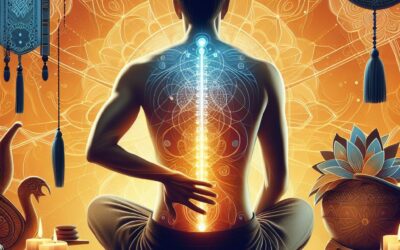Stress is a common problem that affects millions of people around the world. It can cause various mental and physical health issues, such as anxiety, depression, insomnia, headaches, high blood pressure, and heart disease. Stress can also reduce our quality of life and happiness.
Fortunately, there are ways to cope with stress and achieve inner peace and calmness. One of them is Ayurveda, a holistic system of medicine that originated in India thousands of years ago. Ayurveda means “the science of life” and it offers a comprehensive approach to stress management that considers the body, mind, and spirit.
Understanding Stress in Ayurveda
According to Ayurveda, stress is caused by an imbalance in our natural state of harmony. This harmony is determined by our constitution, or prakriti, which is a unique combination of three fundamental energies, or doshas: Vata, Pitta, and Kapha. Each dosha has its own characteristics, functions, and qualities, and they influence our physical, mental, and emotional aspects.
Vata is the energy of movement, creativity, and change. It governs the nervous system, breathing, circulation, and elimination. When Vata is balanced, we feel energetic, enthusiastic, and flexible. When Vata is imbalanced, we feel anxious, restless, and fearful.
Pitta is the energy of transformation, digestion, and metabolism. It governs the fire element, the blood, and the skin. When Pitta is balanced, we feel confident, intelligent, and passionate. When Pitta is imbalanced, we feel angry, irritable, and jealous.
Kapha is the energy of stability, structure, and nourishment. It governs the water and earth elements, the bones, muscles, and fat. When Kapha is balanced, we feel calm, loyal, and compassionate. When Kapha is imbalanced, we feel lazy, dull, and greedy.
Stress can affect any of the doshas, depending on the type, intensity, and duration of the stressor, as well as our individual constitution and lifestyle. For example, a sudden change or loss can aggravate Vata, a deadline or competition can aggravate Pitta, and a lack of stimulation or variety can aggravate Kapha. Therefore, to manage stress effectively, we need to identify our dominant dosha and the factors that disturb its balance.
Ayurvedic Techniques for Stress Relief
Ayurveda offers a variety of techniques to restore the balance of the doshas and reduce stress. Some of the most common and effective ones are:
-
Abhyanga: Abhyanga is a self-massage technique that involves applying warm oil to the entire body, using gentle strokes and circular motions. Abhyanga helps to calm the nervous system, improve blood circulation, lubricate the joints, and nourish the skin. It also promotes relaxation, detoxification, and rejuvenation. Abhyanga can be done daily, preferably in the morning, before taking a shower. The type of oil used depends on the dosha. For example, sesame oil is good for Vata, coconut oil is good for Pitta, and sunflower oil is good for Kapha.
-
Pranayama: Pranayama is a breathing technique that involves controlling the inhalation, exhalation, and retention of the breath. Pranayama helps to balance the energy flow in the body, calm the mind, and enhance concentration. It also improves oxygenation, digestion, and immunity. Pranayama can be done daily, preferably in the morning, on an empty stomach. The type of pranayama used depends on the dosha. For example, alternate nostril breathing (Nadi Shodhana) is good for Vata, cooling breath (Sheetali) is good for Pitta, and bellows breath (Bhastrika) is good for Kapha.
-
Meditation: Meditation is a technique that involves focusing the attention on a single object, sound, or sensation, such as the breath, a mantra, or a candle flame. Meditation helps to quiet the mind, reduce negative thoughts, and increase awareness. It also promotes happiness, peace, and clarity. Meditation can be done daily, preferably in the morning or evening, in a comfortable and quiet place. The type of meditation used depends on the preference and the goal. For example, mindfulness meditation is good for reducing stress, loving-kindness meditation is good for increasing compassion, and transcendental meditation is good for expanding consciousness.
-
Herbal remedies: Herbal remedies are natural substances that have medicinal properties and can help to balance the doshas and alleviate stress. They can be taken in the form of teas, powders, capsules, oils, or ghee. The type of herb used depends on the dosha and the condition. For example, ashwagandha is good for Vata, amla is good for Pitta, and triphala is good for Kapha.
-
Dietary guidelines: Dietary guidelines are recommendations for choosing and preparing foods that suit our constitution and the season. They help to nourish the body, improve digestion, and prevent diseases. The type of food used depends on the dosha and the taste. For example, Vata needs warm, moist, and sweet foods, Pitta needs cool, light, and bitter foods, and Kapha needs hot, dry, and pungent foods.
Daily Ayurvedic Practices for Inner Peace
In addition to the techniques mentioned above, Ayurveda also suggests some daily practices that can help to maintain the balance of the doshas and foster inner peace. Some of the most important ones are:
-
Establishing a daily routine (Dinacharya): Dinacharya is a set of activities that are performed at specific times of the day, according to the natural rhythms of the sun and the moon. Dinacharya helps to create a sense of order, discipline, and harmony in our lives. It also supports our biological clock, digestion, and immunity. Dinacharya includes waking up before sunrise, cleansing the senses, brushing the teeth, scraping the tongue, drinking warm water, exercising, bathing, eating, working, resting, and sleeping.
-
Importance of adequate sleep: Sleep is essential for the health and well-being of the body and the mind. It helps to repair the tissues, rejuvenate the cells, consolidate the memory, and regulate the hormones. It also reduces stress, anxiety, and depression. Ayurveda recommends getting at least seven to eight hours of sleep every night, preferably between 10 pm and 6 am. The quality of sleep depends on the dosha. For example, Vata needs a warm, cozy, and dark environment, Pitta needs a cool, airy, and quiet environment, and Kapha needs a light, spacious, and stimulating environment.
-
Yoga asanas: Yoga asanas are physical postures that are performed with awareness, breath, and alignment. They help to stretch, strengthen, and balance the body, mind, and spirit. They also improve flexibility, posture, circulation, and coordination. Yoga asanas can be done daily, preferably in the morning, after pranayama and before meditation. The type of asana used depends on the dosha and the level. For example, Vata needs gentle, grounding, and stabilizing asanas, Pitta needs cooling, relaxing, and moderating asanas, and Kapha needs vigorous, energizing, and stimulating asanas.
Ayurvedic Tips for Emotional Well-being
Emotions are natural and inevitable aspects of our human experience. They can be positive or negative, depending on how we perceive and react to them. Ayurveda recognizes that emotions have a direct impact on our physical and mental health, and vice versa. Therefore, it offers some tips to balance our emotions and enhance our emotional well-being. Some of the most useful ones are:
-
Balancing emotions through Ayurvedic principles: Ayurveda teaches that emotions are influenced by the doshas, and that each dosha has a predominant emotion. For example, Vata is associated with fear, Pitta with anger, and Kapha with attachment. By understanding our dominant dosha and its emotional tendencies, we can learn to manage our emotions more effectively. For instance, Vata can balance fear by cultivating faith, Pitta can balance anger by cultivating forgiveness, and Kapha can balance attachment by cultivating detachment.
-
Incorporating positive affirmations and gratitude practices: Positive affirmations are statements that express our desired state of being, such as “I am calm”, “I am confident”, or “I am happy”. Gratitude practices are expressions of appreciation for the things that we have, such as “I am grateful for my health”, “I am grateful for my family”, or “I am grateful for my opportunities”. By repeating positive affirmations and gratitude practices daily, preferably in the morning and evening, we can reprogram our subconscious mind, attract positive energy, and enhance our emotional well-being.
Case Studies and Success Stories
To illustrate the effectiveness of Ayurvedic stress management, here are some real-life examples of individuals who have benefited from it and how it has transformed their lives and improved their mental well-being.
-
Ravi, a 35-year-old software engineer, was suffering from chronic stress, anxiety, and insomnia due to his demanding and competitive work environment. He was constantly worried about his deadlines, performance, and future. He had difficulty falling asleep and staying asleep, and often woke up feeling tired and irritable. He also experienced frequent headaches, indigestion, and palpitations. He tried various medications and therapies, but none of them worked for him. He decided to try Ayurveda, after reading about it online. He consulted an Ayurvedic practitioner, who diagnosed him as a Vata-Pitta type and prescribed him a personalized treatment plan. The plan included abhyanga with sesame oil, pranayama with alternate nostril breathing, meditation with a mantra, herbal tea with ashwagandha and brahmi, and dietary changes such as avoiding spicy, sour, and fried foods, and increasing sweet, bitter, and astringent foods. Ravi followed the plan diligently for three months, and noticed a remarkable improvement in his stress levels, sleep quality, and overall well-being. He felt more calm, relaxed, and focused. He also performed better at work and enjoyed his life more.
-
Priya, a 28-year-old teacher, was suffering from chronic stress, depression, and low self-esteem due to her abusive and controlling husband. She was constantly unhappy, fearful, and hopeless. She had no friends, hobbies, or goals. She also experienced frequent mood swings, weight gain, and hair loss. She tried to seek help from her family and friends, but they did not understand or support her. She decided to try Ayurveda, after hearing about it from a colleague. She consulted an Ayurvedic practitioner, who diagnosed her as a Kapha type and prescribed her a personalized treatment plan. The plan included abhyanga with sunflower oil, pranayama with bellows breath, meditation with a candle flame, herbal tea with triphala and guggulu, and dietary changes such as avoiding sweet, salty, and oily foods, and increasing pungent, bitter, and astringent foods. Priya followed the plan diligently for three months, and noticed a remarkable improvement in her stress levels, mood, and self-esteem. She felt more confident, cheerful, and hopeful. She also lost weight, regained her hair, and left her abusive husband.
-
Raj, a 40-year-old businessman, was suffering from chronic stress, hypertension, and heart disease due to his hectic and competitive lifestyle. He was constantly busy, ambitious, and aggressive. He had no time for relaxation, recreation, or relationships. He also experienced frequent anger, frustration, and resentment. He tried various medications and surgeries, but they only provided temporary relief. He decided to try Ayurveda, after reading about it in a magazine. He consulted an Ayurvedic practitioner, who diagnosed him as a Pitta type and prescribed him a personalized treatment plan. The plan included abhyanga with coconut oil, pranayama with cooling breath, meditation with a mantra, herbal tea with amla and neem, and dietary changes such as avoiding pungent, sour, and salty foods, and increasing sweet, bitter, and astringent foods. Raj followed the plan diligently for three months, and noticed a remarkable improvement in his stress levels, blood pressure, and heart health. He felt more peaceful, compassionate, and forgiving. He also reduced his workload, improved his relationships, and enjoyed his life more.
Integrating Ayurveda into Modern Lifestyles
Ayurveda is not only a system of medicine, but also a way of life. It teaches us how to live in harmony with ourselves, with others, and with nature. It helps us to achieve optimal health, happiness, and fulfillment. However, many people may wonder how to integrate Ayurveda into their modern lifestyles, which are often fast-paced, stressful, and complex. Here are some practical tips to incorporate Ayurveda into our daily lives:
-
Start small: Ayurveda does not require us to make drastic or sudden changes in our habits or routines. Rather, it encourages us to make gradual and consistent improvements that suit our individual needs and preferences. We can start by choosing one or two Ayurvedic techniques or practices that appeal to us, and try to implement them regularly. For example, we can start by doing abhyanga once a week, or drinking herbal tea once a day, or meditating for 10 minutes every morning. As we experience the benefits of these practices, we can gradually increase their frequency, duration, and intensity, and add more practices as we go along.
-
Be flexible: Ayurveda does not impose rigid or fixed rules or regulations on us. Rather, it offers us guidelines and suggestions that can be adapted and modified according to our constitution, condition, and situation. We can be flexible and creative in applying Ayurveda to our lives, and experiment with different options and alternatives that work for us. For example, we can vary the type of oil, herb, or food that we use, depending on our dosha, season, and availability. We can also adjust the time, place, and method of our practices, depending on our schedule, environment, and convenience.
-
Be mindful: Ayurveda does not focus on the quantity or outcome of our actions. Rather, it emphasizes the quality and awareness of our actions. We can be mindful and attentive in everything that we do, and observe how it affects our body, mind, and spirit. We can also listen to our inner wisdom and intuition, and follow what feels right and good for us. For example, we can pay attention to how we breathe, eat, move, think, and feel, and notice the changes and improvements that occur. We can also tune in to our natural urges and signals, and respond to them appropriately and timely.
Conclusion
Stress is a universal and inevitable phenomenon that can have negative impacts on our physical, mental, and emotional well-being. However, we can learn to cope with stress and achieve inner peace and calmness by using Ayurveda, a holistic and ancient system of medicine that offers a comprehensive and personalized approach to stress management. Ayurveda helps us to understand the root cause of our stress, balance our doshas, and restore our harmony. It also provides us with various techniques and practices, such as abhyanga, pranayama, meditation, herbal remedies, dietary guidelines, daily routines, sleep, yoga, emotional balancing, positive affirmations, and gratitude practices, that can help us to relieve stress and enhance our well-being. Moreover, Ayurveda can be easily integrated into our modern lifestyles, by starting small, being flexible, and being mindful. By embracing Ayurveda, we can transform our lives and achieve optimal health, happiness, and fulfillment. 🙏













